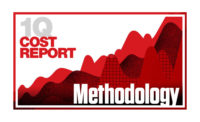What do you say about a year in which the world economy rebounded nicely from the first COVID-19 pandemic shocks but then saw the price of some steel products double in the 12 months from July 2020 to July 2021? Under those conditions, how do you assess a project schedule and price your work?
The construction industry's kaleidoscopic risk picture approaching 2022 includes supply-chain volatility, potential new spikes in material costs, workforce shortages and the heightened focus on sustainability and equity. Cost-cutting strategies and implementation of new technologies and designs may further accelerate risks, says Yann Dreyer, a group practice lead for insurer Allianz, in a recent company report. Also add in volatility introduced by jittery financial markets and political conflict, and you have an unprecedented number of variables.
Above all there is the continuing global COVID-19 crisis. By mid 2021, the Delta variant had ended the idea that the pandemic was drawing to a close in the developed world. Now, with Omicron, day-by-day calculations about whether to travel, whether to mask and how to socially distance are back again.
The material price inflation that has bedeviled construction, forcing postponement or trimming of some projects, and guesswork about when and how to buy materials, is now the focus of worldwide economic policy.
The material price inflation that has bedeviled construction, forcing postponement or trimming of some projects, and guesswork about when and how to buy materials, is now the focus of worldwide economic policy. Hoping to tame inflation before it creates even more havoc, the U.S. Federal Reserve announced this week a new schedule of interest rate increases aimed at keep things under control.
Consultant HKA, in its annual CRUX Insight report on conflicts and disputes around the world, gave perhaps the darkest assessment of what we saw in 2021.
After examining 440 projects in 18 countries in North and South America, HKA wrote that in addition to worsening existing problems, construction now is haunted by “failures to include inflation clauses, assign appropriate contingencies, schedule correctly or manage slack.”
One potential benefit the firm foresees in the recent crisis: increased reporting requirements about costs and delays may cut down on spurious contract claims and help catch defects earlier.
For all the change the industry has seen, there is a stubbornly familiar dimension to the kinds of risks that flare up. Allianz reports that fire is responsible for slightly more than one-quarter of the value of all engineering and construction insurance claims it counts across several world markets. Faulty design and poor workmanship account for 20%.
Insurance costs in the U.S. also promise to keep rising, although more slowly than in recent years, and juries continue to deliver the kinds of huge damage awards that keep insurers up at night. In July, a Boone County, Ky., state jury awarded $25 million in damages and another $50 million in punitive penalties in a lawsuit against a state asphalt paving contractor by the children of a woman who died in a horrific auto accident The children's attorney says they settled to avoid additional litigation about the huge damages, but the amount certainly was far more than any pre-trial settlement.
As the new federal infrastructure financing infusion brings even more projects to the market, it’s fair to say that the worries ENR foresaw for 2021 are still present heading into 2022—but with even more confusion about whether the risk picture will clarify later in the year.




Post a comment to this article
Report Abusive Comment